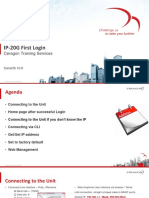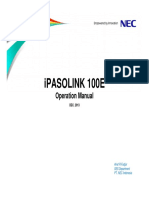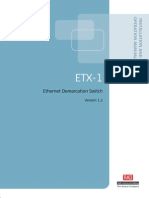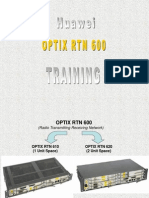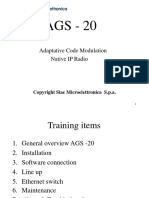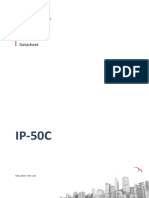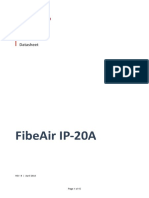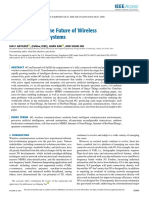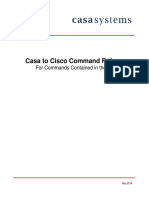Datasheet
IP-50CX
September 2024 | Rev C.01
Page 1 of 4
� Note: For feature availability, check the Release Notes for Ethernet Features
the CeraOS version you are using.
MTU – 9612 Bytes
Up to 1024 Ethernet services, plus one pre-defined
Radio management service
MAC address learning with 32K MAC addresses
Supported Frequency Range Quality of Service:
6-42 GHz • Multiple Classification criteria (VLAN ID, P-bits, IPv4 DSCP,
IPv6 TC, MPLS EXP)
Radio Configurations
• 8 CoS queues per port
1+0 up to 4+0 Single/Dual Polarization, 1+1/2+2 HSB,
2+0 XPIC, 2x2+0 East/West Single/Dual Polarization* • WRED
• P-bit marking/remarking
Radio Features
VLAN add/remove
4+0 Layer 1 Aggregation
G.8032 Ethernet Ring Protection Switching (ERPS)
Layer 1 Aggregation with IP-20C and IP-20C-HP†
Multiple Spanning Tree Protocol (MSTP)
Layer 1 Link Bonding with IP-20N or IP-20A†
Y.1731 Ethernet OAM
Enhanced Multi-Carrier ABC (up to 2+0)
Y.1731 Ethernet Bandwidth Notification (ETH-BN)
Protection: 1+1 HSB/2+2 HSB†
High spectral utilization: BPSK to 4096 QAM w/ACM
Management Protocols
Channel bandwidth: 14 to 224 MHz
SNMP
XPIC
REST
Multiband with Layer 1 Link Bonding (with IP-50E)
NETCONF/YANG
Ethernet Synchronization Protocols
Enhanced Ethernet Equipment Clock (eEEC) Specification
Ethernet Interfaces (G.8262.1)
Port 1: PTP Telecom Boundary Clock (T-BC) and Time Slave Clock (T-
• DC Port TSC) Specification (G.8273.2)
Port 2: PTP Telecom Transparent Clock (T-TC) Specification (G.8273.3)
• RJ-45 - Electric 100Mbps/1Gbps traffic interface Enhanced SyncE Network Limits (G.8261, clause 9.2.1)
Port 3: Enhanced PTP Network Limits (G.8271.1)
• SFP+ – 1/2.5/10 traffic interface Ethernet Synchronization Messaging Channel (ESMC) (G.8264,
clause 11)
Port 4:
PTP Telecom Profile for phase/time synchronization with full
• SFP28 – 1/10/25G traffic interface timing support from the network (G.8275.1) as T-BC
Port 5: PTP Telecom Profile for phase/time synchronization with partial
• RJ-45 – Management/Protection interface - 100 Base-T timing support from the network (G.8275.2) as T-TC
Notes: SFP and SFP+ devices must be of industrial grade Precision Time Protocol (version 2, IEEE1588-2008)
(-40°C to +85°C, -40°F to +185°F).
For information on supported interface usage and
speed per CeraOS release, refer to the Release Notes
or Technical Description for the release.
* †
Not all configurations are supported in every CeraOS release. Planned for future release.
For details about supported configurations, refer to the
Release Notes for the CeraOS version you are using.
Page 2 of 4
�Standards Technical Specifications
Supported Ethernet Standards Mechanical Specifications
10/100/1000base-T/X (IEEE 802.3) Dimensions – 270mm(H), 230mm(W), 98mm(D), 5.3 kg
10GBase-LR (IEEE 802.3) Pole Diameter Range (for Remote Mount Installation) –
Ethernet VLANs (IEEE 802.3ac) 8.89 cm – 11.43 cm
Virtual LAN (VLAN, IEEE 802.1Q) Environmental Specifications
Class of service (IEEE 802.1p)
-33C to +55C
Provider bridges (QinQ – IEEE 802.1ad) -27F to +131F
Link aggregation (IEEE 802.1AX)
Auto MDI/MDIX for 1000baseT
Power Input Specifications
RFC 1349: IPv4 TOS Standard Input: -48 VDC
RFC 2474: IPv4 DSCP DC Input range: -40.5 to -60 VDC
RFC 2460: IPv6 Traffic Classes Power Consumption Specifications
Security Typical Power Consumption:
Radio Encryption – AES 256* 2+0 Operation:
• 6-11 GHz: 85W
Secured protocols:
• 13-15 GHz: 66W
• HTTPS
1+0 Operation (one carrier muted):
• SNMPv3
• 6-11 GHz: 66W
• SSH
• 13-15 GHz: 58W
• SFTP
Both carriers muted:
RADIUS authentication and authorization
• 6-11 GHz: 41W
TACACS+ Authentication, Authorization, and Accounting
• 13-15 GHz: 43W
(session-based)
Note: The maximum power consumption can be up to ~20%
Standards Compliance higher than the typical figures listed above.
Radio Spectral Efficiency: FCC Part 101, EN 302 217-2
EMC: EN 301 489-1, EN 301 489-4, Class B (Europe), FCC 47 CFR,
part 15, class B (US), ICES-003, Class B (Canada), TEC/EMI/TEL-
001/01, Class B (India)
Surge: EN61000-4-5, Class 4 (for PWR and ETH1 ports)
Safety: EN 60950-1, IEC 60950-1, UL 60950-1, CSA-C22.2
No.60950-1, EN 60950-22, UL 60950-22, CSA C22.2.60950-22
Storage: ETSI EN 300 019-1-1 Class 1.2
Transportation: ETSI EN 300 019-1-2 Class 2.
* Not supported in the initial release.
Page 3 of 4
�Product Image
Page 4 of 4







